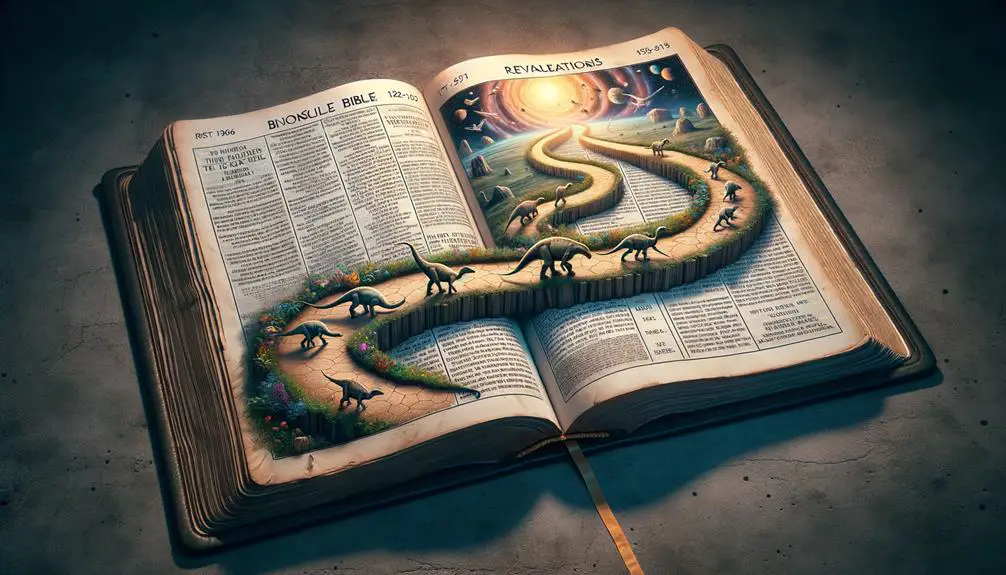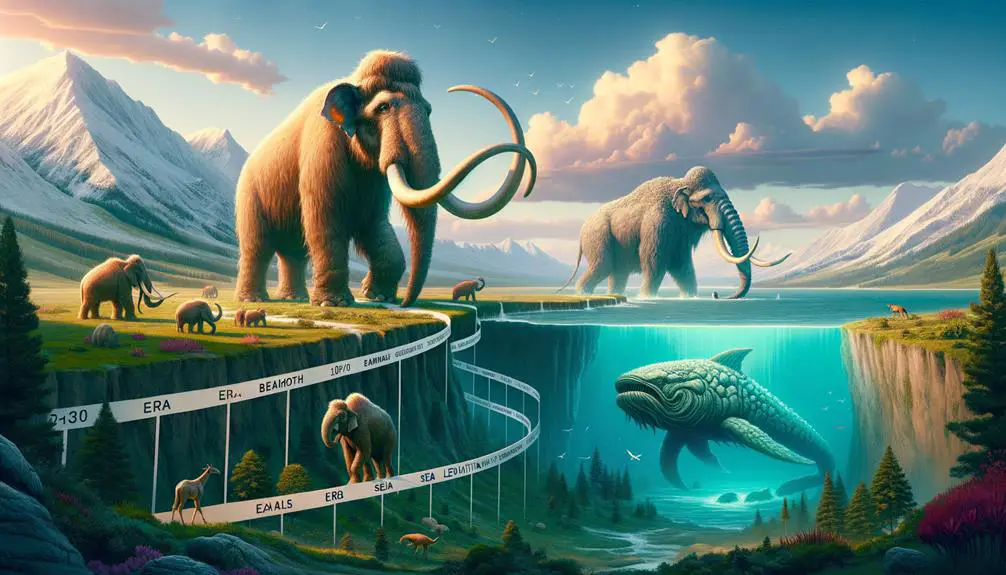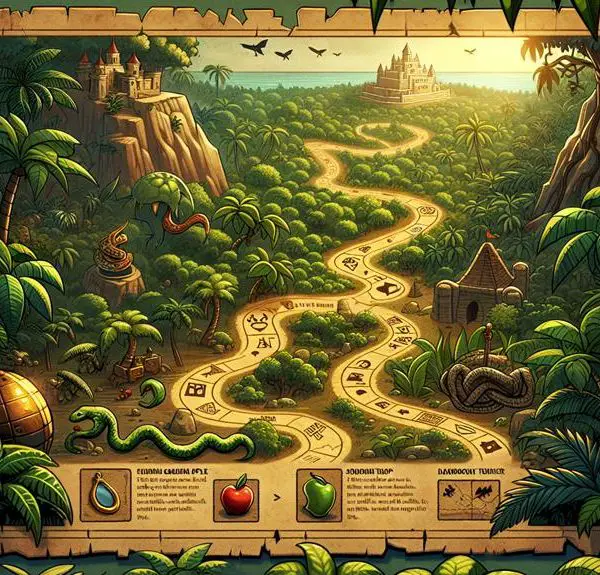Where do dinosaurs fit in the biblical timeline? Explore the intersection of faith and science in this intriguing discussion.

Where Do Dinosaurs Fit in the Bible Timeline
Imagine navigating a dense forest without a compass; this mirrors the challenge you face when trying to position dinosaurs within the biblical timeline.
The Bible doesn't specifically mention these colossal creatures, leading to a fascinating intersection of faith and science you've likely pondered. Various theories have emerged, attempting to reconcile the scientific existence of dinosaurs with biblical narratives.
From interpreting the days of creation to analyzing creatures like Behemoth and Leviathan, the debate spans wide. As you consider the implications for both faith and our understanding of history, you'll find intriguing perspectives that challenge conventional views.
Why should this matter to you? Keep exploring to uncover how this discussion might reshape the way you view the ancient world and its scriptural narratives.
Key Takeaways
- Dinosaurs are not explicitly mentioned in the Bible due to the ancient focus on spiritual truths over natural history.
- Scientific evidence places dinosaurs over 160 million years before humans, outside the biblical human timeline.
- Biblical references to creatures like Behemoth and Leviathan may symbolize ancient understanding of large, unknown animals, possibly including dinosaurs.
- Integrating scientific findings about dinosaurs with biblical narratives invites a richer understanding of God's creation and the complexity of life on Earth.
Biblical Silence on Dinosaurs

Although the Bible encompasses a vast array of narratives and teachings, it doesn't explicitly mention dinosaurs, raising intriguing questions about their place within a faith-informed understanding of history. You're delving into an area where ancient interpretations and cultural perspectives intersect, offering a unique lens through which to view the silence of the Scriptures on such magnificent creatures.
Ancient interpretations of the biblical text didn't have the benefit of modern paleontology. The faithful of those times interpreted their world through the stories and teachings passed down through generations, which focused more on moral and spiritual lessons than on cataloging the natural world. This absence of dinosaurs in the narrative isn't surprising; the focus was on humanity's relationship with the divine, not on providing a comprehensive history of the Earth's flora and fauna.
Moreover, cultural perspectives of the time weren't oriented towards scientific inquiry in the way we understand it today. The ancient peoples contextualized their understanding of the world through myths, legends, and divine interventions, which were far more significant to their worldview than physical evidence of ancient creatures. This cultural lens shaped the content of the Bible, focusing on human history and spiritual teachings rather than on the details of Earth's prehistoric past.
Your exploration into the biblical silence on dinosaurs reveals a complex interplay between the limitations of ancient understanding and the priorities of cultural narratives. It highlights how the Scriptures were crafted with specific intentions, guiding you towards spiritual and moral truths rather than providing an exhaustive history of the planet's biological diversity.
Scientific Timeline of Dinosaurs
You'll find that the scientific timeline of dinosaurs provides a fascinating juxtaposition to biblical narratives.
By examining the era in which dinosaurs roamed, alongside the timeline of their fossil discoveries, you're embarking on a journey that bridges faith with scientific inquiry.
This exploration not only enriches our understanding but also highlights the complementary nature of science and faith in interpreting our world's history.
Dinosaur Era Overview
Understanding the scientific timeline of dinosaurs provides a fascinating glimpse into God's creation, showcasing an era that spanned over 160 million years before humankind's presence on Earth. This period, marked by dramatic shifts in the Jurassic climate and catastrophic extinction events, invites us to marvel at the complexity and resilience of life.
- Jurassic Climate: A time of warm temperatures and lush vegetation, supporting diverse dinosaur life.
- Extinction Events: Cataclysmic moments that reshaped ecosystems, leading to the eventual demise of dinosaurs.
- Divine Timing: Each era unfolds within God's sovereign timeline, revealing lessons in adaptability and the transient nature of earthly dominions.
Fossil Discovery Timeline
The timeline of fossil discovery unveils how God's intricate design of dinosaurs was gradually revealed to humanity, marking significant milestones in our understanding of the prehistoric world.
Through the lens of radiometric dating, scientists have pinpointed the age of dinosaur fossils with remarkable accuracy, bridging the gap between faith and science. This method, alongside advanced paleontological methods, has allowed us to piece together the history of these magnificent creatures.
By examining the layers of the earth, researchers have uncovered evidence of dinosaurs' existence millions of years ago, challenging us to reconcile these findings with our faith.
Through this journey of discovery, we're reminded of the complexity of God's creation, as each fossil unearthed tells a story of a world long gone, yet integral to our own.
Theories Linking Dinosaurs and the Bible

Several theories have emerged that seek to bridge the ancient narratives of the Bible with the existence of dinosaurs, proposing intriguing intersections of faith and science. These theories often delve into creation myths and extinction debates, offering a scholarly, faith-informed perspective on where these magnificent creatures fit within the biblical narrative.
- Gap Theory: This posits a significant gap of time between Genesis 1:1 and 1:2, suggesting that dinosaurs lived and became extinct during this period. It reconciles the ancient age of dinosaur fossils with the biblical account of creation, presenting a timeline where dinosaurs predate human existence.
- Day-Age Theory: Some scholars interpret the 'days' of creation in Genesis as symbolic of longer periods. In this view, dinosaurs could have roamed the earth during one of these extended 'days,' aligning the biblical creation account with geological and fossil evidence.
- Behemoth and Leviathan: A more literal interpretation finds potential references to dinosaurs directly in scripture. Job 40 describes Behemoth with a tail like a cedar tree, and Job 41 speaks of Leviathan, a sea monster. These descriptions have led some to speculate that the Bible may indeed reference dinosaurs, albeit not by the name we know them today.
Through these theories, you can see a deep engagement with both the biblical text and scientific discoveries, avoiding the pitfalls of simplistic interpretations. This approach respects the complexity of both realms, seeking to understand how ancient faith narratives and modern scientific findings can illuminate one another.
Dinosaurs and the Days of Creation
Exploring the days of creation in Genesis, one can't help but ponder where dinosaurs fit into this divine timeline. When you delve into Genesis interpretation, it's clear that the text doesn't explicitly mention dinosaurs. However, Creationist views offer intriguing insights into how these magnificent creatures might align with the biblical account of the world's origins.
Creationists often argue that dinosaurs were created during the first six days of creation, particularly pointing to the fifth and sixth days when God created sea creatures, birds, and land animals. They suggest that dinosaurs, as land animals, would logically fall into the category of creatures created on the sixth day. This perspective aligns with a literal interpretation of Genesis, suggesting that all land animals, including dinosaurs, coexisted with humans shortly after their creation.
Analyzing these viewpoints requires a faith-informed, scholarly approach. You must consider the broader context of Genesis and how it sets the stage for understanding the natural world through a divine lens. The key isn't to isolate dinosaurs as anomalies within the biblical narrative but to integrate them into the overarching story of creation.
This integration raises further questions about the interplay between scientific discoveries and biblical interpretation. Creationist views, while varied, share a common belief in the infallibility of Scripture. They challenge you to look beyond the surface, encouraging a deeper exploration of how science and faith can coexist. As you reflect on the days of creation, it becomes evident that the presence of dinosaurs in the biblical timeline invites a rich, nuanced dialogue between the worlds of science and faith.
Interpreting the Behemoth and Leviathan

When delving into biblical texts, you'll find that the figures of Behemoth and Leviathan offer a fascinating glimpse into the ancient world's understanding of creatures that might resemble what we know today as dinosaurs. These entities, often shrouded in mythical interpretations, serve as a bridge between the realms of faith and the natural world as perceived by ancient civilizations. Their descriptions in scripture have sparked considerable debate among scholars and theologians, attempting to reconcile these ancient depictions with modern scientific discoveries.
The Behemoth and Leviathan aren't merely creatures of fantasy but are emblematic of the power and mystery of God's creation. Their mention in the Bible serves a deeper purpose, illustrating:
- The Limitations of Human Understanding: These creatures highlight the vastness of God's creation that goes beyond human comprehension. Their mythical interpretations underscore our ongoing quest to understand the natural world.
- The Diversity of God's Creation: Ancient depictions of Behemoth and Leviathan suggest a world teeming with creatures beyond our current knowledge. This diversity points to the richness and complexity of life, as created by God.
- The Symbolism in Sacred Texts: Beyond their literal existence, these beings carry symbolic weight, representing chaos, strength, and the untamable aspects of nature that only God can control.
In analyzing these biblical figures, one must tread carefully between literal and figurative interpretations, appreciating the depth and richness they add to our understanding of the Bible. The mythical interpretations and ancient depictions of Behemoth and Leviathan invite us to explore the boundaries of our knowledge and faith, encouraging a deeper reflection on the mysteries of creation.
Implications for Faith and Science
In bridging the gap between faith and science, the discussion around Behemoth and Leviathan challenges us to reevaluate our understanding of biblical narratives in light of modern paleontological discoveries. This intersection invites you to explore how faith reconciliation and scientific literacy can coexist, enhancing your comprehension of the world and the scripture.
Aspect |
Implication |
|---|---|
Biblical Interpretation |
Encourages open-mindedness towards scriptural analysis. |
Scientific Discoveries |
Validates the pursuit of knowledge within a faith framework. |
Educational Approach |
Advocates for integrated learning, blending spiritual and empirical understanding. |
Community Dialogue |
Fosters discussions that respect diverse viewpoints. |
Personal Faith Journey |
Deepens spiritual conviction through informed reflection. |
You're called to navigate these waters with a spirit of curiosity and humility, recognizing that the quest for truth doesn't diminish your faith but rather enriches it. By engaging with both the biblical text and the fossil record, you're participating in a conversation that spans centuries, contributing to a more nuanced faith that appreciates God's creation in all its complexity.
This journey towards faith reconciliation and enhanced scientific literacy isn't just about resolving the question of dinosaurs in the Bible. It's about embracing a holistic view of your beliefs, allowing you to appreciate the marvels of the natural world and the spiritual truths conveyed through scripture. In doing so, you're not only deepening your understanding but also bridging gaps that have, for too long, been sources of division among communities of faith.
Frequently Asked Questions
How Do Different Christian Denominations Interpret the Absence or Presence of Dinosaurs in the Biblical Narrative?
Different Christian denominations have varied takes on dinosaur fossils and their place in the biblical narrative, reflecting diverse cultural interpretations.
You'll find some view these ancient creatures as part of the pre-Adamic world, not mentioned explicitly due to their irrelevance to salvation history.
Others might see them as creatures that lived alongside early humans, suggesting a young Earth.
This range of beliefs showcases the intersection of faith, science, and cultural understanding in interpreting sacred texts.
Are There Any Historical or Ancient Texts Outside the Bible That Might Reference Creatures Resembling Dinosaurs?
You're navigating a sea of ancient texts, unearthing dragon myths and cultural depictions that may mirror dinosaurs. These historical documents, from Chinese annals to Mesopotamian tablets, aren't just tall tales. They serve as a scholarly bridge, connecting the dots between faith and prehistoric life.
Analyzing these sources, you gain insight into how cultures interpreted these colossal creatures, offering a faith-informed perspective on the possible coexistence of humans and dinosaur-like beings.
How Do Proponents of Theistic Evolution Reconcile the Existence of Dinosaurs With the Biblical Account of Creation?
You're navigating how theistic evolution proponents merge dinosaurs' existence with the biblical creation story. They lean on evolutionary theology, viewing the Genesis account through scriptural metaphors rather than literal days. This approach suggests that God used evolutionary processes, including dinosaurs, as part of creation.
What Role Do Dinosaurs Play in Modern Christian Apologetics and Debates Regarding the Age of the Earth?
In modern Christian apologetics, dinosaurs often highlight debates on Earth's age. You'll find that proponents leverage scientific evidence, including the fossil record, to argue for either a young or old Earth viewpoint.
This involves analyzing how such evidence aligns or conflicts with biblical interpretations. The role dinosaurs play is crucial, as their existence and dating challenge or support various theological frameworks, urging a deeper, faith-informed dialogue on creation and the timeline of life on Earth.
How Do Children's Religious Education Programs Address the Topic of Dinosaurs in the Context of Biblical Teachings?
In your exploration of how children's religious education tackles dinosaurs within biblical teachings, you'll find a blend of creativity and scholarship.
Programs often incorporate dinosaur crafts alongside paleontology lessons, aiming to harmonize faith with scientific understanding. This approach not only enriches kids' knowledge but also encourages critical thinking.
Conclusion
In conclusion, bridging the gap between the scientific timeline of dinosaurs and the biblical narrative requires a nuanced understanding and an open heart.
As the adage goes, 'Absence of evidence isn't evidence of absence.'
The Bible's silence on dinosaurs doesn't negate their existence nor undermine faith.
By exploring theories like the Behemoth and Leviathan, we navigate the complex waters of faith and science, reminding us that divine mystery and earthly discovery can coexist in our quest for truth.



Sign up